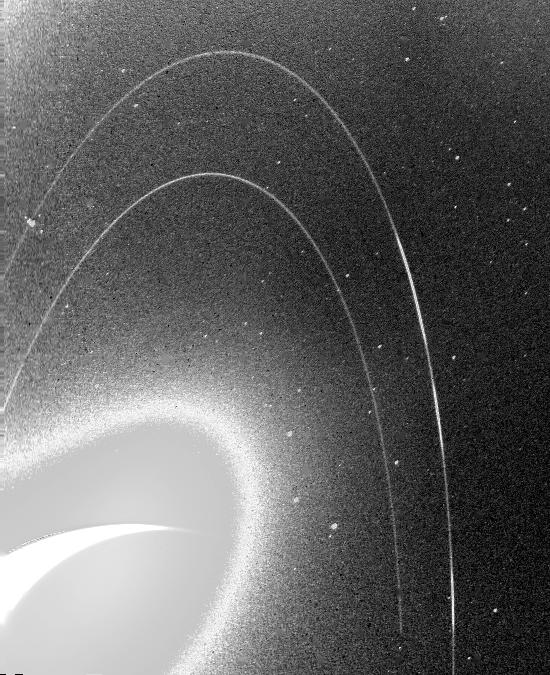Saturn’s rings are easy to love. They’re hauntingly beautiful reminders of how insignificant we are in the scope of the universe. But they also unfairly outshine the rest of the gas giants’ ring systems. Uranus, for example, is a wonderland encompassed by at least 13 rings. Jupiter has its own ghostly rings, too. But perhaps the biggest underdog in the pack are the rings of Neptune — and that’s gotta change.
A look at some of Neptune’s rings from Voyager 2. (Image: NASA)
It’s crazy to think we didn’t confirm the existence of Neptune’s rings until 1989, when NASA’s Voyager 2 probe performed its flyby of the planet. Voyager 2 was able to give us a glimpse into the elusive world and its five rings — Galle, Le Verrier, Lassell, Arago and Adams — which are all named after astronomers who studied the gas giant. But even before Voyager 2 arrived in the Neptunian system, astronomer and Villanova professor Dr Edward Guinan had spotted unusual dimming patterns around the planet in 1968. In 1982, he and some colleagues reassessed their data, and realised they’d actually found two rings.
Most people don’t know about Neptune’s rings because frankly, they’re pretty difficult to see. Saturn’s rings are big and icy and super reflective, whereas Neptune’s are pretty dim. “They’re small pieces of ice and dust, usually like snowflake-size, though some are several feet across,” Guinan told Gizmodo. “How they [may have] formed is that an asteroid or moon tried to form in that region and it got tidally ripped apart, being next to such a big planet.” According to this idea, the scattered debris then formed a ring, like beautiful, swirling garbage.

A Voyager 2 snap of Neptune’s rings. (Image: NASA/JPL)
Neptune’s rings (which are a few thousand kilometres wide each, at most), while much less broad than Saturn’s (about 282,000km across), are still pretty fascinating. The outermost ring, called “Adams”, has three unusual arcs known as Liberty, Equality and Fraternity (shout out to the former history majors who’ll understand). According to NASA, the arcs are probably shaped the way they are due to the gravitational effects of one of Neptune’s 13 moons, Galatea.
Sadly, we haven’t come close to Neptune since the 1980s. It doesn’t seem like NASA or other space agencies have any immediate plans to go back, although a Cassini-style orbiter mission would definitely clear up many questions about the Neptunian ring system.
“There’s nothing that really got near [Neptune], so it’d be really good,” Guinan said, when asked if we should send a probe there. “Uranus would be a good one [to visit] too, because Uranus is sideways,” he added, referring to the fact that the planet’s spin axis is tilted 98 degrees, which is pretty bonkers.
The outer solar system is weird. Neptune is very weird. It’s also wonderful, and its rings deserve your love.
